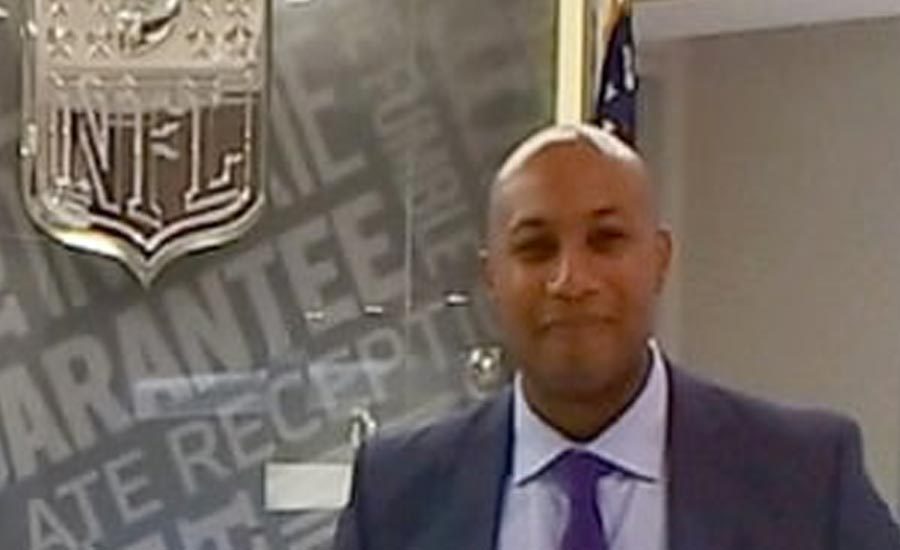COVID-19 Heroes
The NFL’s GSOC takes center stage in getting players back on the field
As the centralized place for intelligence and information, the NFL’s GSOC played a pivotal role in the League’s pandemic response, streamlining access and infection control, updating business continuity plans, and providing relevant data to enable all stakeholders to make informed decisions.

The NFL’s GSOC proved its worth over and over during the COVID-19 pandemic, becoming a trusted source for relevant information, as well as a centralized place for streamlining COVID-19 response workflow.
Image courtesy of NFL

Robert Gummer.
Image courtesy of Gummer


The National Football League (NFL) is centered around live games and large crowds, as well as close proximity between players, extensive travel for teams and executives, programmatic public appearances, and all varieties of in-person interactions. COVID-19 created safety and security risks that struck at the core of the League’s business model, as well as the business models of partner organizations.
So how could the NFL still have a 2020 season while keeping executives, employees and partners safe during a once-in-a-lifetime pandemic? That was the central question Robert Gummer and his colleagues had to answer quickly. As Director of Intelligence Operations at the NFL in charge of the League’s Global Security Operations Center (GSOC), he’s responsible for identification and mitigation of threats to all league equities, activities and facilities, including personnel, staff, stadiums, teams and athletes. In addition to analyzing risk and mitigation, the GSOC is responsible for the travel risk protection program and emergency notification across the entire organization. The GSOC team supports every game and every event under the League’s purview.
Gummer has been in the intelligence community for over 23 years, starting as an army Intel officer for 8 years. He taught army intelligence for nearly four years before working for the Federal Bureau of Investigation. During his tenure, his experience included managing intelligence teams that supported violent gang and drug trafficking investigations, counterterrorism efforts, and assessing the health and effectiveness of intelligence programs. In his last position, he served as the Senior National Intelligence Officer of Science and Technology. In 2018, he was recruited to the NFL to build the League’s GSOC from scratch and create an intelligence apparatus to monitor for threats and inform business decisions and strategy along with adding a layer of resilience to business continuity and emergency preparedness.
In the early days of building the GSOC, like anything new within an organization, there was a question of its worth, Gummer says. “The pandemic changed everything forever — not only our role within the organization, but how necessary it is to navigate something like this with a centralized place of security- related information for the organization,” he says.
Initially, the NFL’s GSOC was charged with providing weekly insights to all stakeholders, but soon, the team became key enablers for the return to work, return to play and more. Gummer became the go-to resource for operational intelligence to all stakeholders, uniting them together in order to coordinate activities and make decisions based on the same information, and ultimately enabling the League to design a 2020 season that concluded with the Super Bowl LIV.
Leveraging his deep experience as an intelligence analyst to guide the approach, Gummer and the GSOC team considered potential COVID-19 impact on all aspects of operations, including travel, gaming integrity, supply chain, partners, etc. With the security team’s help, the League took a thoughtful and comprehensive approach to business continuity that put data-informed critical decision-making at the forefront of the pandemic response. The GSOC:
- Identified the data and information needed to inform NFL executives and guide operational decision-making;
- Coordinated response plans with national and regional partners;
- Became a trusted advisor to the various NFL business units and partners.
“In order to tackle something like this, you need to be dynamic and nimble,” Gummer says. “Our team is not only experienced and agile, but we also communicate a lot, and it’s our shared experiences and differences that have helped us be able to handle anything that comes our way and do so as a team.”
In addition to supplying all of the information needed to make critical decisions, Gummer and the GSOC team worked with the security department and other business units to adjust existing business continuity plans, which were suited to many other disasters and disruptions for a shutdown of three to five days or even up to 30, but certainly not a pandemic with a highly contagious and novel virus that would last indefinitely. Adapting the business continuity plans were critical to allowing League play to resume.
The GSOC’s success can be attributed to many things, says Gummer, including a team of intelligence personnel experienced in sifting through and analyzing large volumes of information quickly and efficiently; a high-level of communication from the GSOC to all necessary stakeholders, as well as smart use of technologies.
In terms of technology, Gummer made the prudent decisions to facilitate a virtual GSOC from its inception as well as incorporate web-based technologies for greater situational awareness and intelligence accessible from any location. These design decisions made before the pandemic realized an even greater value once the pandemic hit and the GSOC could continue operations with minimal interruption.
“It was lucky that we had these technologies already in place because it allowed us global visibility that no one else in the League has access too,” Gummer notes.
The League’s pandemic response workflow has been streamlined by the GSOC, infection control officers, events staff and other security teams working hand-in-hand to allow for a robust, cross-functional workflow.
“We have been told multiple times that [the GSOC] went from being a ‘nice to have’ to a ‘must have,’” Gummer says. “Before COVID, we were the ‘cool toy,’ but after 2020 we have become indispensable and that’s a huge leap. We work hand-in-hand with every business unit in the League.”
Looking for a reprint of this article?
From high-res PDFs to custom plaques, order your copy today!








